Sensitivity of Human Thermal Comfort Benchmarks to Background Temperature and Individual Factors: An Empirical Study in Wuhan, China
Abstract
1. Introduction
2. Methodology
2.1. Study Area
2.2. Site Selection for the Field Experiment and Questionnaire Surveys
2.3. Meteorological Measurement
2.4. Questionnaire Survey
2.5. Thermal Comfort Index and Analysis
2.6. Analytical Objectives
3. Results
3.1. Percentage of Thermal Sensation Vote
3.2. Percentage of Thermal Comfort Vote
4. Analysis of the Thermal Benchmarks with Different Individuals and Weather Temperatures
4.1. Relationship Between TSV and TCV
4.1.1. Analysis of Different Weather Temperatures
4.1.2. Analysis of Different Age Groups
4.1.3. Analysis of Different Genders
4.2. Analysis of Thermal Neutral Temperature in Winter
4.2.1. Analysis of Different Age Groups
4.2.2. Analysis of Different Genders
4.3. Analysis of Thermal Neutral Temperature in Summer
4.3.1. Analysis of Different Age Groups
4.3.2. Analysis of Different Genders
4.4. Analysis of Thermal Acceptable Temperature Range with Individual Groups
4.4.1. Analysis of Different Age Groups
4.4.2. Analysis of Different Genders
4.5. Comparison of Results with Other Studies
4.5.1. Effect of Age Differences on Thermal Benchmarks
4.5.2. Comparative Analysis of Different Geographical Regions
4.6. Analysis of Thermal Adaptive Behaviors with Individual Groups
4.6.1. Analysis of Different Age Groups
4.6.2. Analysis of Different Genders
4.7. Summary and Design Implications
4.8. Limitations
5. Conclusions
Author Contributions
Funding
Data Availability Statement
Acknowledgments
Conflicts of Interest
Abbreviations
| MTCV | Mean TCV |
| MTSV | Mean TSV |
| NPET | Neutral PET (°C) |
| NPETR | Neutral PET range (°C) |
| NUTCI | Neutral UTCI (°C) |
| NUTCIR | Neutral UTCI range (°C) |
| OTC | Outdoor thermal comfort |
| PET | Physiological equivalent temperature (°C) |
| RH | Relative humidity (%) |
| Ta | Air temperature (°C) |
| TAR | Thermal acceptability range |
| TAV | Thermal acceptability vote |
| TCV | Thermal comfort vote |
| Tg | Black globe temperature (°C) |
| Tmrt | Mean radiant temperature (°C) |
| TSV | Thermal sensation vote |
| UTCI | Universal thermal climate index (°C) |
| Va | Wind speed (m/s) |
References
- Global Temperature|Vital Signs—Climate Change: Vital Signs of the Planet, (n.d.). Available online: https://climate.nasa.gov/vital-signs/global-temperature/?intent=121 (accessed on 27 September 2024).
- Zhao, Q.; Guo, Y.; Ye, T.; Gasparrini, A.; Tong, S.; Overcenco, A.; Urban, A.; Schneider, A.; Entezari, A.; Vicedo-Cabrera, A.M.; et al. Global, regional, and national burden of mortality associated with non-optimal ambient temperatures from 2000 to 2019: A three-stage modelling study. Lancet Planet. Health 2021, 5, e415–e425. [Google Scholar] [CrossRef]
- Dong, Y.; Ren, Z.; Fu, Y.; Hu, N.; Guo, Y.; Jia, G.; He, X. Decrease in the residents’ accessibility of summer cooling services due to green space loss in Chinese cities. Environ. Int. 2022, 158, 107002. [Google Scholar] [CrossRef]
- Yang, M.; Li, Y.; Du, Y.; Wang, Y.; Fei, W.; Huang, J.; Liang, J. What is the outdoor thermal comfort (OTC) threshold in Gulangyu, China: An empirical study. Urban Clim. 2024, 56, 102086. [Google Scholar] [CrossRef]
- Amaripadath, D.; Rahif, R.; Velickovic, M.; Attia, S. A systematic review on role of humidity as an indoor thermal comfort parameter in humid climates. J. Build. Eng. 2023, 68, 106039. [Google Scholar] [CrossRef]
- Liu, K.; Lian, Z.; Dai, X.; Lai, D. Comparing the effects of sun and wind on outdoor thermal comfort: A case study based on longitudinal subject tests in cold climate region. Sci. Total Environ. 2022, 825, 154009. [Google Scholar] [CrossRef]
- Liu, Y.; Zhang, G.; Yang, W. Dynamic estimation of urban heat exposure for outdoor jogging: Combining individual trajectory and mean radiant temperature. Urban Clim. 2024, 55, 101871. [Google Scholar] [CrossRef]
- Xie, X.; Sun, Z.; Zhu, X.; Zhao, S.; Wang, Z.; Zhai, Y. Influence of misting system on the thermal environment and thermal comfort of seated people in semi-outdoor space in Xi’an, China. Front. Archit. Res. 2024, 13, 668–681. [Google Scholar] [CrossRef]
- Nikolopoulou, M. Outdoor thermal comfort. Front. Biosci. (Sch. Ed.) 2011, 3, 1552–1568. [Google Scholar] [CrossRef]
- Jin, H.; Liu, S.; Kang, J. Gender differences in thermal comfort on pedestrian streets in cold and transitional seasons in severe cold regions in China. Build. Environ. 2020, 168, 106488. [Google Scholar] [CrossRef]
- Yuan, T.; Hong, B.; Qu, H.; Liu, A.; Zheng, Y. Outdoor thermal comfort in urban and rural open spaces: A comparative study in China’s cold region. Urban Clim. 2023, 49, 101501. [Google Scholar] [CrossRef]
- Huang, Z.; Cheng, B.; Gou, Z.; Zhang, F. Outdoor thermal comfort and adaptive behaviors in a university campus in China’s hot summer-cold winter climate region. Build. Environ. 2019, 165, 106414. [Google Scholar] [CrossRef]
- Su, Y.; Wu, Z.; Gao, W.; Wang, C.; Zhao, Q.; Wang, D.; Li, J. Summer outdoor thermal comfort evaluation of urban open spaces in arid-hot climates. Energy Build. 2024, 321, 114679. [Google Scholar] [CrossRef]
- Baquero Larriva, M.T.; Higueras García, E. Thermal Comfort for the Elderly: A Systematic Review of the Scientific Literature. Rev. Esp. Geriatr. Gerontol. 2019, 54, 280–295. [Google Scholar] [CrossRef]
- Xu, T.; Yao, R.; Du, C.; Li, B. Outdoor thermal perception and heatwave adaptation effects in summer—A case study of a humid subtropical city in China. Urban Clim. 2023, 52, 101724. [Google Scholar] [CrossRef]
- Xiong, K.; He, B.-J. Wintertime outdoor thermal sensations and comfort in cold-humid environments of Chongqing China. Sustain. Cities Soc. 2022, 87, 104203. [Google Scholar] [CrossRef]
- Kim, Y.; Brown, R.D. Climate-sensitive street design: Evaluating summer pedestrian activity and behavioral thermal adaptation on the high line. NYC. Build. Environ. 2025, 281, 113203. [Google Scholar] [CrossRef]
- Xu, T.; Yao, R.; Du, C.; Li, B.; Fang, F. A quantitative evaluation model of outdoor dynamic thermal comfort and adaptation: A year-long longitudinal field study. Build. Environ. 2023, 237, 110308. [Google Scholar] [CrossRef]
- Zou, J.; Yu, Y.; Mortezazadeh, M.; Lu, H.; Gaur, A.; Wang, L. Evaluating Climate Change Impacts on Building Level Steady-State and Dynamic Outdoor Thermal Comfort. Build. Environ. 2025, 271, 112604. [Google Scholar] [CrossRef]
- Huang, B.; Matzarakis, A.; He, B.-J. Nonlinear law of cumulative heat exposure and dynamic thermal comfort during pedestrians’ walking: Field experiments and machine learning predictions. Sustain. Cities Soc. 2025, 131, 106696. [Google Scholar] [CrossRef]
- Ji, Y.; Song, J.; Shen, P. A review of studies and modelling of solar radiation on human thermal comfort in outdoor environment. Build. Environ. 2022, 214, 108891. [Google Scholar] [CrossRef]
- Kumar, P.; Sharma, A. Study on importance; procedure, and scope of outdoor thermal comfort—A review. Sustain. Cities Soc. 2020, 61, 102297. [Google Scholar] [CrossRef]
- Potchter, O.; Cohen, P.; Lin, T.-P.; Matzarakis, A. Outdoor human thermal perception in various climates: A comprehensive review of approaches, methods and quantification. Sci. Total Environ. 2018, 631–632, 390–406. [Google Scholar] [CrossRef]
- Zhang, S.; Zhang, X.; Niu, D.; Fang, Z.; Chang, H.; Lin, Z. Physiological equivalent temperature-based and universal thermal climate index-based adaptive-rational outdoor thermal comfort models. Build. Environ. 2023, 228, 109900. [Google Scholar] [CrossRef]
- Deng, X.; Nie, W.; Li, X.; Wu, J.; Yin, Z.; Han, J.; Pan, H.; Lam, C.K.C. Influence of built environment on outdoor thermal comfort: A comparative study of new and old urban blocks in Guangzhou. Build. Environ. 2023, 234, 110133. [Google Scholar] [CrossRef]
- Bröde, P.; Fiala, D.; Błażejczyk, K.; Holmér, I.; Jendritzky, G.; Kampmann, B.; Tinz, B.; Havenith, G. Deriving the operational procedure for the Universal Thermal Climate Index (UTCI). Int. J. Biometeorol. 2012, 56, 481–494. [Google Scholar] [CrossRef]
- Luo, M.; Guo, F.; Tang, H.; Ming, R.; Huang, L.; Zhao, H. A Systematic Review of the Influence of Physiological Factors on Outdoor Thermal Comfort. Hum. Settl. Sustain. 2025, 1, 27–40. [Google Scholar] [CrossRef]
- Cheung, P.K.; Jim, C.Y. Comparing the cooling effects of a tree and a concrete shelter using PET and UTCI. Build. Environ. 2018, 130, 49–61. [Google Scholar] [CrossRef]
- Kozak, M.; Lipecki, T. The impact of green walls on outdoor thermal comfort in residential areas under warm weather conditions: A case study. Urban Clim. 2025, 62, 102541. [Google Scholar] [CrossRef]
- Lai, D.; Guo, D.; Hou, Y.; Lin, C.; Chen, Q. Studies of outdoor thermal comfort in northern China. Build. Environ. 2014, 77, 110–118. [Google Scholar] [CrossRef]
- Liu, W.; Zhang, Y.; Deng, Q. The effects of urban microclimate on outdoor thermal sensation and neutral temperature in hot-summer and cold-winter climate. Energy Build. 2016, 128, 190–197. [Google Scholar] [CrossRef]
- Hadianpour, M.; Mahdavinejad, M.; Bemanian, M.; Nasrollahi, F. Seasonal differences of subjective thermal sensation and neutral temperature in an outdoor shaded space in Tehran, Iran. Sustain. Cities Soc. 2018, 39, 751–764. [Google Scholar] [CrossRef]
- Cheung, P.K.; Jim, C.Y. Improved assessment of outdoor thermal comfort: 1-hour acceptable temperature range. Build. Environ. 2019, 151, 303–317. [Google Scholar] [CrossRef]
- Cheng, B.; Gou, Z.; Zhang, F.; Feng, Q.; Huang, Z. Thermal comfort in urban mountain parks in the hot summer and cold winter climate. Sustain. Cities Soc. 2019, 51, 101756. [Google Scholar] [CrossRef]
- Sharmin, T.; Steemers, K.; Humphreys, M. Outdoor thermal comfort and summer PET range: A field study in tropical city Dhaka. Energy Build. 2019, 198, 149–159. [Google Scholar] [CrossRef]
- Kenawy, I.; Lam, C.K.C.; Shooshtarian, S. Summer outdoor thermal benchmarks in Melbourne: Applications of different techniques. Build. Environ. 2021, 195, 107658. [Google Scholar] [CrossRef]
- Ma, X.; Tian, Y.; Du, M.; Hong, B.; Lin, B. How to design comfortable open spaces for the elderly? Implications of their thermal perceptions in an urban park. Sci. Total Environ. 2021, 768, 144985. [Google Scholar] [CrossRef]
- Silva, T.J.V.; Hirashima, S.Q.S. Predicting urban thermal comfort from calibrated UTCI assessment scale—A case study in Belo Horizonte city, southeastern Brazil. Urban Clim. 2021, 36, 100652. [Google Scholar] [CrossRef]
- Mei, Y.; Xu, L. Research on Seasonal Thermal Neutral Temperature in West Lake Scenic Area of Hangzhou, China. Int. J. Environ. Res. Public Health 2022, 19, 14677. [Google Scholar] [CrossRef]
- Manavvi, S.; Rajasekar, E. Evaluating outdoor thermal comfort in urban open spaces in a humid subtropical climate: Chandigarh, India. Build. Environ. 2022, 209, 108659. [Google Scholar] [CrossRef]
- Wei, D.; Yang, L.; Bao, Z.; Lu, Y.; Yang, H. Variations in outdoor thermal comfort in an urban park in the hot-summer and cold-winter region of China. Sustain. Cities Soc. 2022, 77, 103535. [Google Scholar] [CrossRef]
- Wang, W.; Li, Y.; Li, L.; Wang, R.; Wang, Y. Study on thermal comfort of elderly in community parks: An exploration from the perspectives of different activities and ages. Build. Environ. 2023, 246, 111001. [Google Scholar] [CrossRef]
- He, X.; Gao, W.; Wang, R.; Yan, D. Study on outdoor thermal comfort of factory areas during winter in hot summer and cold winter zone of China. Build. Environ. 2023, 228, 109883. [Google Scholar] [CrossRef]
- Zhang, H.; Wang, Y.; Guo, F.; Zhao, J.; Dong, J.; Zhu, P. Factors influencing outdoor thermal comfort in a coastal park during the transition seasons in cold regions of China. Urban. Clim. 2024, 55, 101856. [Google Scholar] [CrossRef]
- Li, Z.; Zhou, L.; Hong, X.; Qiu, S. Outdoor thermal comfort and activities in urban parks: An experiment study in humid subtropical climates. Build. Environ. 2024, 253, 111361. [Google Scholar] [CrossRef]
- Heidari, A.; Davtalab, J.; Sargazi, M.A. Effect of awning on thermal comfort adjustment in open urban space using PET and UTCI indexes: A case study of Sistan region in Iran. Sustain. Cities Soc. 2024, 101, 105175. [Google Scholar] [CrossRef]
- Al Tahir, I.; El Fattah, A.A.; Mohammed, M.; Asif, M.; Almahdy, O. Evaluating the performance of outdoor shading devices on human thermal comfort in hot humid climates: A case study of Dhahran. Build. Environ. 2025, 271, 112625. [Google Scholar] [CrossRef]
- Cai, M.; Li, M.; Liu, H. Optimizing cooling efficiency of urban greenspaces across local climate zones in Wuhan, China. Urban For. Urban Green. 2025, 105, 128691. [Google Scholar] [CrossRef]
- Zhang, C.; Xu, S.; Qi, C.; Dai, R.; Mendis, T.; Wang, M. Comparison of Thermal Comfort in Different Subway Spaces in China’s Hot Summer and Cold Winter Region: A Field Investigation Based on Subway Station Transition. Buildings 2025, 15, 786. [Google Scholar] [CrossRef]
- METAR TAF: Wuhan Tianhe International Airport, Wuhan, People’s Republic of China. (n.d.). Available online: https://zh.allmetsat.com/metar-taf/china.php?icao=ZHHH (accessed on 9 August 2025).
- Qin, H.; Ma, Y.; Niu, J.; Huo, J.; Wei, X.; Yan, J.; Han, G. Investigating differences of outdoor thermal comfort for the elderly among genders across seasons: A case study in Chongqing, China. Urban Clim. 2025, 61, 102398. [Google Scholar] [CrossRef]
- Standard 55—Thermal Environmental Conditions for Human Occupancy, (n.d.). Available online: https://www.ashrae.org/technical-resources/bookstore/standard-55-thermal-environmental-conditions-for-human-occupancy (accessed on 27 September 2024).
- Ainsworth, B.E.; Haskell, W.L.; Herrmann, S.D.; Meckes, N.; Bassett, D.R.J.; Tudor-Locke, C.; Greer, J.L.; Vezina, J.; Whitt-Glover, M.C.; Leon, A.S. 2011 Compendium of Physical Activities: A Second Update of Codes and MET Values. Med. Sci. Sports Exerc. 2011, 43, 1575. [Google Scholar] [CrossRef]
- ISO 8996: 2021, ISO (n.d.). Available online: https://www.iso.org/standard/74443.html (accessed on 9 August 2025).
- Lin, Z.; Yang, R.; Li, K.; Yi, G.; Li, Z.; Guo, J.; Zhang, Z.; Junxiang, P.; Liu, Y.; Qi, S.; et al. Establishment of age group classification for risk stratification in glioma patients. BMC Neurol. 2020, 20, 310. [Google Scholar] [CrossRef]
- Meng, F.; Qin, M.; Gao, Z.; Wang, H.; Xu, X.; Xu, F. A review of RayMan in thermal comfort simulation: Development, applications and prospects. Build. Environ. 2025, 270, 112547. [Google Scholar] [CrossRef]
- Johansson, E.; Thorsson, S.; Emmanuel, R.; Krüger, E. Instruments and methods in outdoor thermal comfort studies—The need for standardization. Urban Clim. 2014, 10, 346–366. [Google Scholar] [CrossRef]
- Yao, R.; Li, Y.; Du, C.; Li, B. A ‘heart rate’-based model (PHSHR) for predicting personal heat stress in dynamic working environments. Build. Environ. 2018, 135, 318–329. [Google Scholar] [CrossRef]
- High Temperature Warning Science, (n.d.). Available online: https://www.cma.gov.cn/yjkp/202111/t20211104_4194712.html (accessed on 14 March 2025).
- Xu, X.; Lian, Z. A sleep staging model based on core body temperature rhythm. Energy Build. 2024, 310, 114099. [Google Scholar] [CrossRef]
- Natsume, K.; Ogawa, T.; Sugenoya, J.; Ohnishi, N.; Imai, K. Preferred ambient temperature for old and young men in summer and winter. Int. J. Biometeorol. 1992, 36, 1–4. [Google Scholar] [CrossRef]
- Zhao, Q.; Liu, J.; Sullivan, N.; Chang, K.; Spina, J.; Blasch, E.; Chen, G. Anomaly detection of unstructured big data via semantic analysis and dynamic knowledge graph construction. In Proceedings of the Signal Processing, Sensor/Information Fusion, and Target Recognition XXX, Online, 12–17 April 2021; Volume 11756, p. 117560N. [Google Scholar] [CrossRef]
- Su, X.; Li, Y.; Gu, C.; Liu, Z.; Yang, B.; Hong, B. A modified COMFA model for elderly people in outdoor environments. Sustain. Cities Soc. 2023, 99, 104940. [Google Scholar] [CrossRef]
- Li, C.; Wu, J.; Fan, C.; Sun, B.; Hu, Z. Human thermal perception in extremely cold environments: A study of overall and local responses. Energy Build. 2024, 303, 113773. [Google Scholar] [CrossRef]
- Larriva, M.T.B.; Higueras, E. Health risk for older adults in Madrid, by outdoor thermal and acoustic comfort. Urban Clim. 2020, 34, 100724. [Google Scholar] [CrossRef]
- Taylor, N.A.S.; Allsopp, N.K.; Parkes, D.G. Preferred Room Temperature of Young vs Aged Males: The Influence of Thermal Sensation, Thermal Comfort, and Affect. J. Gerontol. Ser. A 1995, 50, M216–M221. [Google Scholar] [CrossRef]
- Lindner-Cendrowska, K.; Błażejczyk, K. Impact of selected personal factors on seasonal variability of recreationist weather perceptions and preferences in Warsaw (Poland). Int. J. Biometeorol. 2018, 62, 113–125. [Google Scholar] [CrossRef]
- Anderson, G.S.; Meneilly, G.S.; Mekjavic, I.B. Passive temperature lability in the elderly. Europ. J. Appl. Physiol. 1996, 73, 278–286. [Google Scholar] [CrossRef]
- Seino, K.; Nakamura, K.; Alemi, S. Social interactions and heat stress mitigation among elderly people in a healthy city. Lancet Planet. Health 2024, 8, S12. [Google Scholar] [CrossRef] [PubMed]
- Mishra, N.K.; Vance, M.E.; Novoselac, A.; Patel, S. Dynamic optimization of personal exposure and energy consumption while ensuring thermal comfort in a test house. Build. Environ. 2024, 252, 111265. [Google Scholar] [CrossRef]
- Oliveira, S.; Andrade, H. An initial assessment of the bioclimatic comfort in an outdoor public space in Lisbon. Int. J. Biometeorol. 2007, 52, 69–84. [Google Scholar] [CrossRef]
- Yochihara, Y.; Ohnaka, T.; Nagai, Y.; Tokuda, T.; Kawashima, Y. Physiological responses and thermal sensations of the elderly in cold and hot environments. J. Therm. Biol. 1993, 18, 355–361. [Google Scholar] [CrossRef]
- Maeda, T.; Kobayashi, T.; Tanaka, K.; Sato, A.; Kaneko, S.-Y.; Tanaka, M. Seasonal Differences in Physiological and Psychological Responses to Hot and Cold Environments in the Elderly and Young Males; Tochihara, Y., Ohnaka, T., Eds.; Elsevier Ergonomics Book Series; Elsevier: Amsterdam, The Netherlands, 2005; pp. 35–41. [Google Scholar] [CrossRef]
- Yung, E.H.K.; Wang, S.; Chau, C. Thermal perceptions of the elderly, use patterns and satisfaction with open space. Landsc. Urban Plan. 2019, 185, 44–60. [Google Scholar] [CrossRef]
- Li, J.; Liu, N. The perception, optimization strategies and prospects of outdoor thermal comfort in China: A review. Build. Environ. 2020, 170, 106614. [Google Scholar] [CrossRef]
- Zhou, S.; Xu, X.; Xu, H.; Zhao, Z.; Yuan, H.; Wang, Y.; Qiao, R.; Wu, T.; Jia, W.; Wang, M.; et al. From heat resilience to sustainable co-benefits: Adaptive urban morphology generation based on multimodal data fusion and a novel generative framework. Sustain. Cities Soc. 2025, 127, 106452. [Google Scholar] [CrossRef]
- Zhou, S.-Q.; Yu, Z.-W.; Ma, W.-Y.; Yao, X.-H.; Xiong, J.-Q.; Ma, W.-J.; Xiang, S.-Y.; Yuan, Q.; Hao, Y.-Y.; Xu, D.-F.; et al. Vertical canopy structure dominates cooling and thermal comfort of urban pocket parks during hot summer days. Landsc. Urban Plan. 2025, 254, 105242. [Google Scholar] [CrossRef]
- Xu, J.; Xu, X.; Wang, Z.; Chen, H.; Ren, Q.; Huang, H.; Cui, Y.; An, R.; Liu, Y. Investigating thermal exposure during daily walking through a human-scale approach: An analysis of a hot summer in Wuhan. Build. Environ. 2024, 264, 111932. [Google Scholar] [CrossRef]
- Kim, J.Y.; Park, C.Y.; Hyun, J.H.; Kim, S.H.; Yun, S.H.; Lee, D.K.; Kim, J.Y. Landscape Design for Improved Thermal Environment: An Optimized Tree Arrangement Design for Climate-Responsive Outdoor Spaces in Residential Buildings Complexes. Sustain. Cities Soc. 2023, 97, 104762. [Google Scholar] [CrossRef]
- Uchiyama, Y.; Kyan, A.; Sato, M.; Ushimaru, A.; Minamoto, T.; Kiyono, M.; Harada, K.; Takakura, M. Local environment perceived in daily life and urban green and blue space visits: Uncovering key factors for different age groups to access ecosystem services. J. Environ. Manag. 2024, 370, 122676. [Google Scholar] [CrossRef]


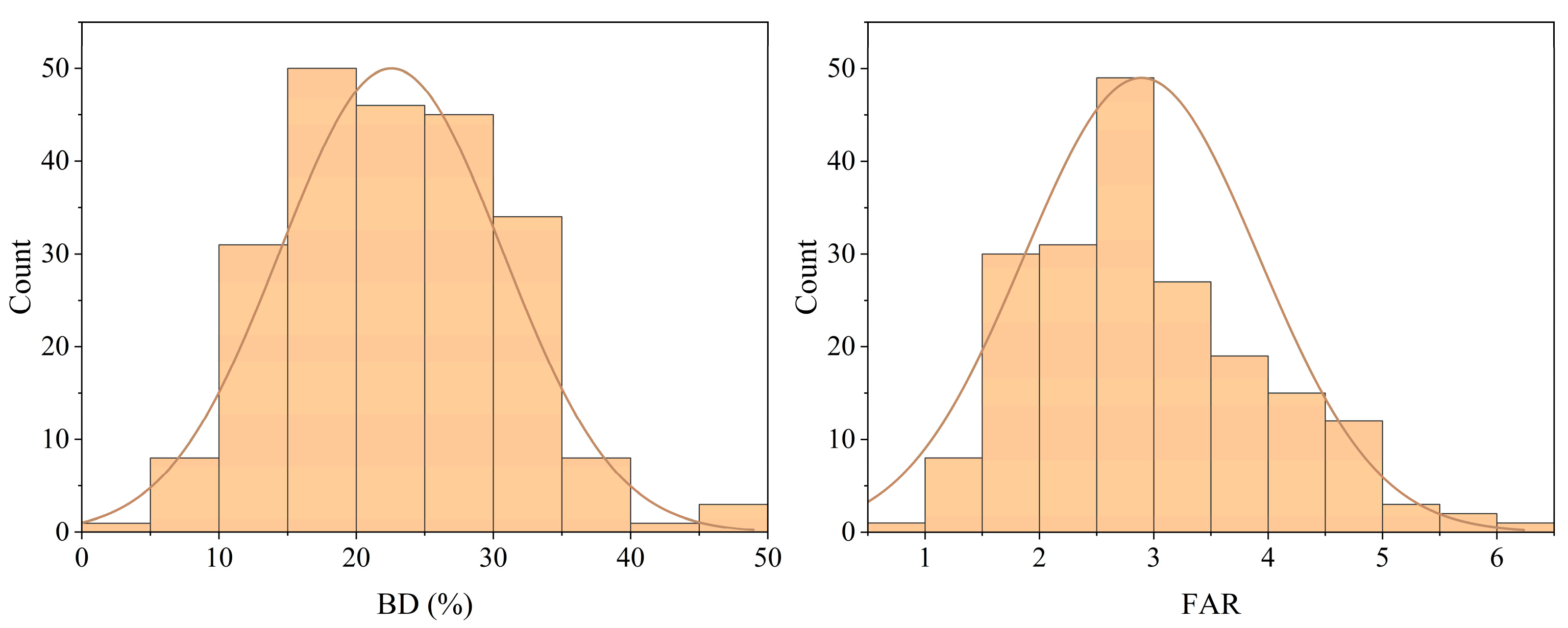




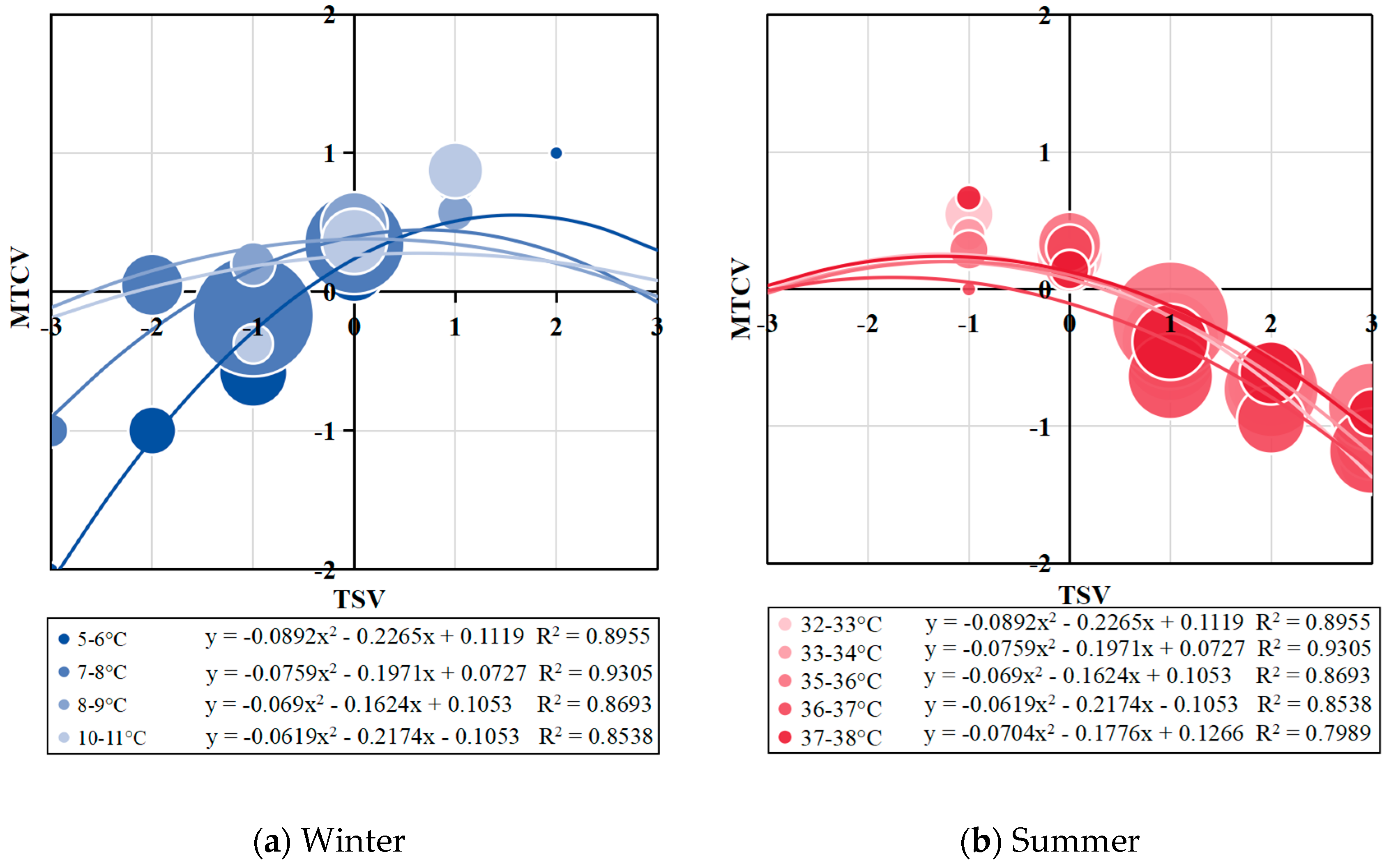

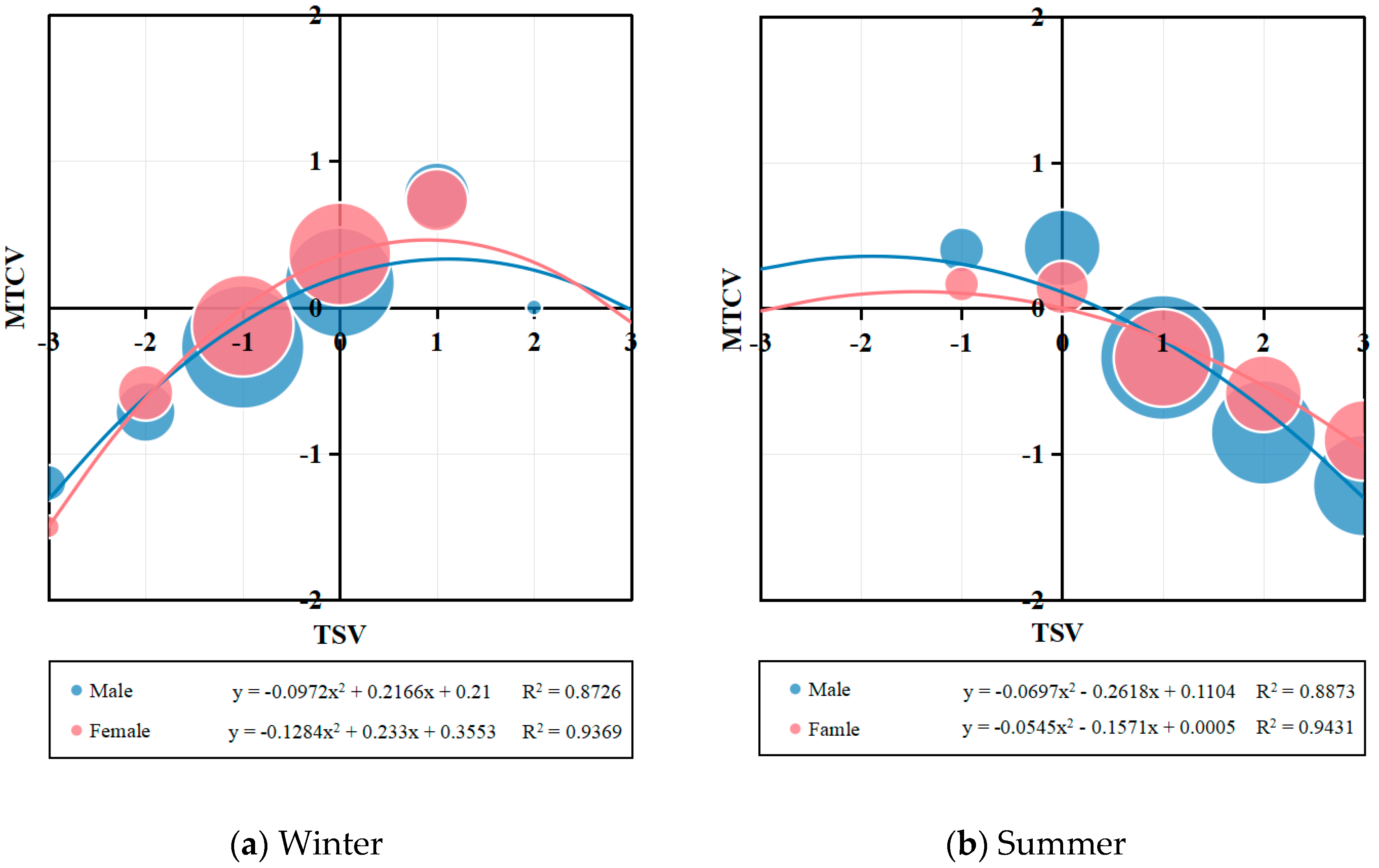
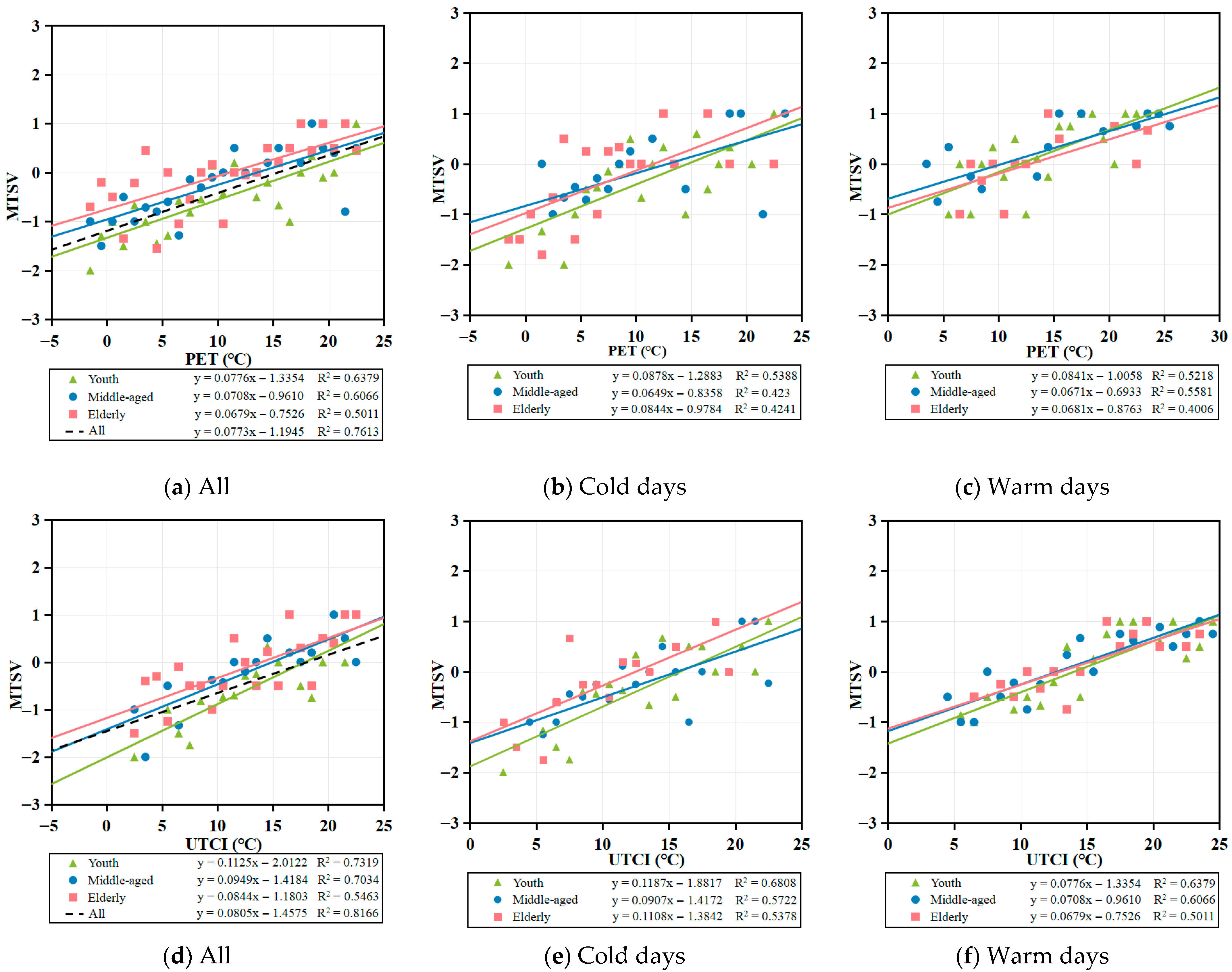
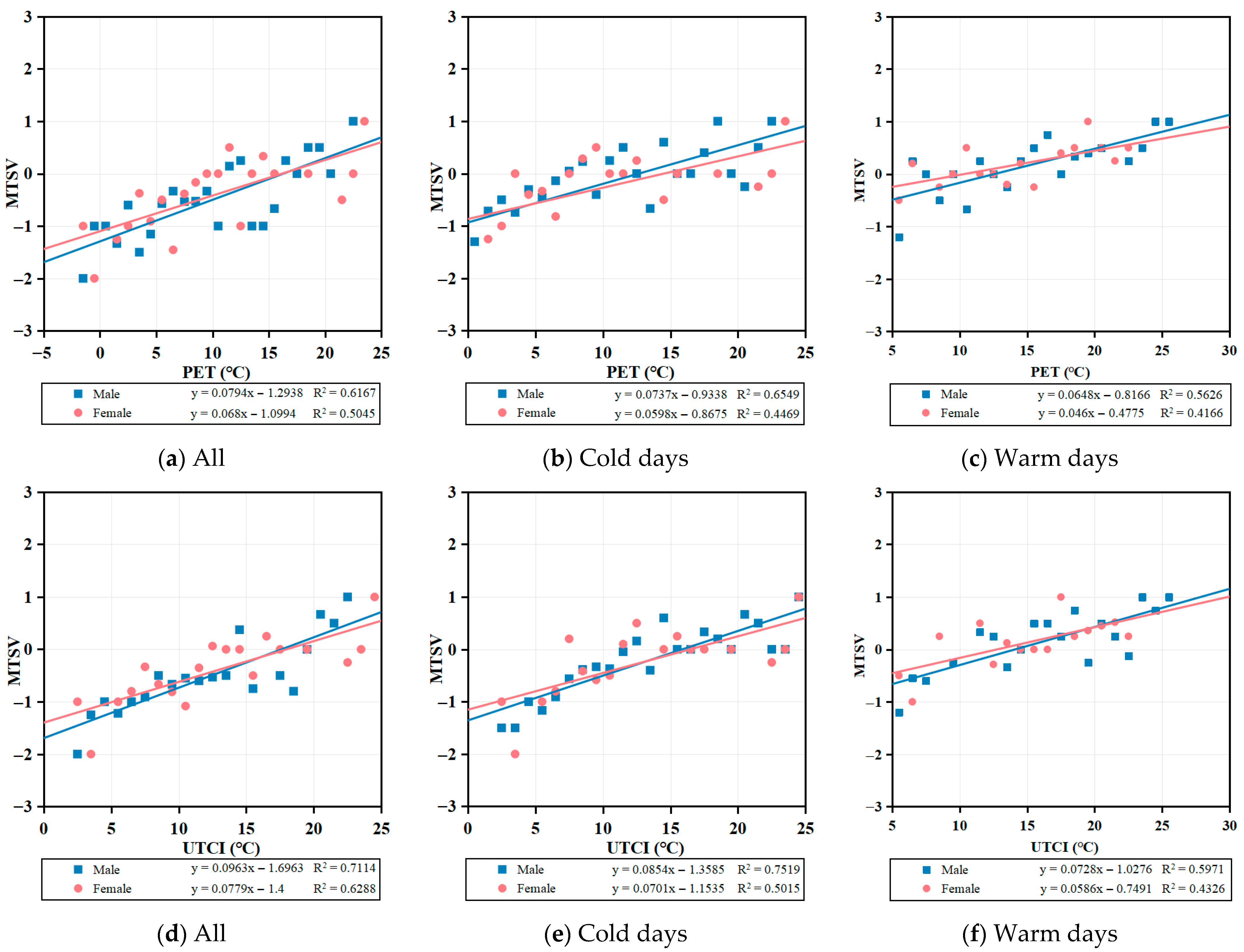

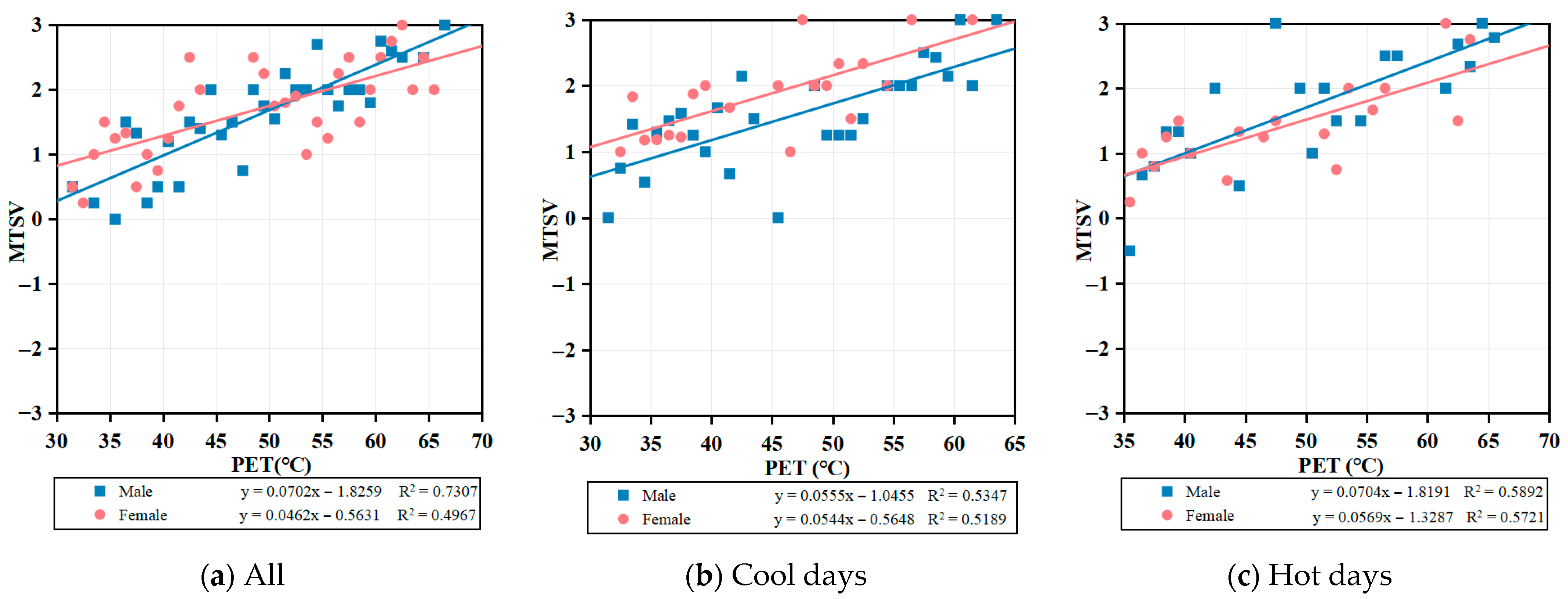
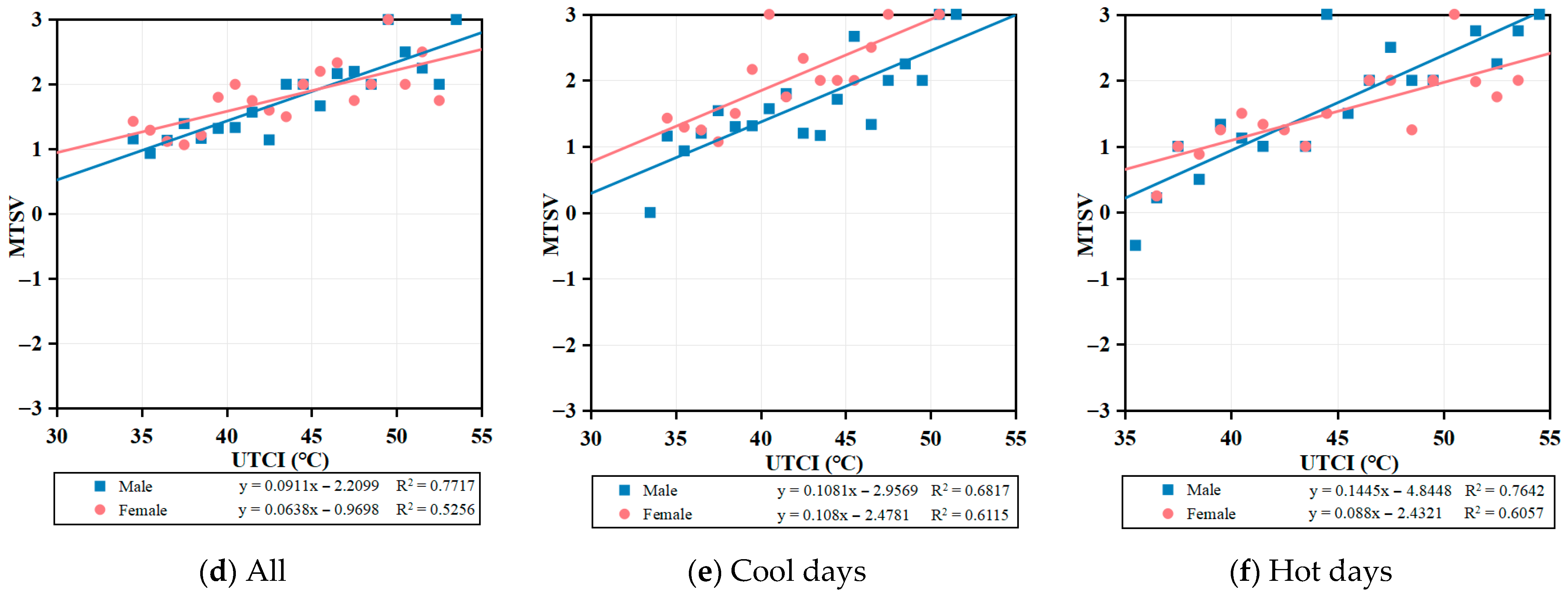


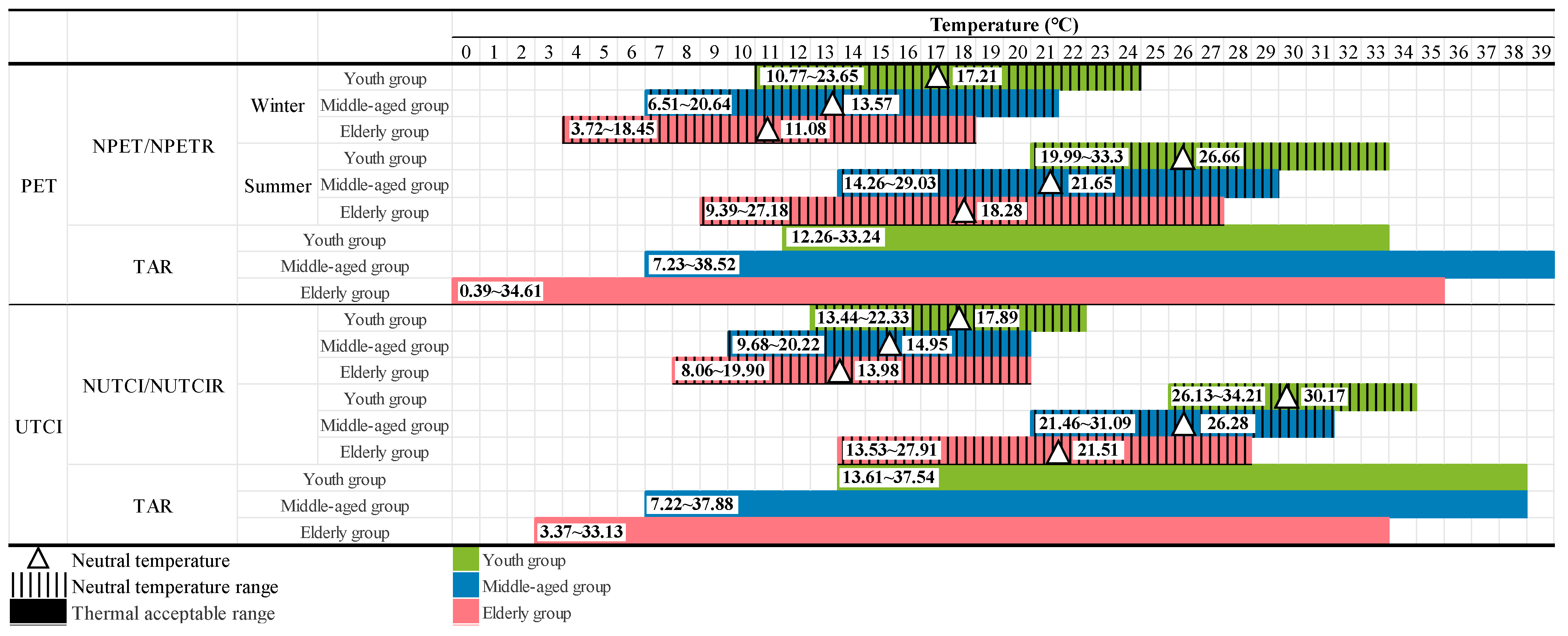
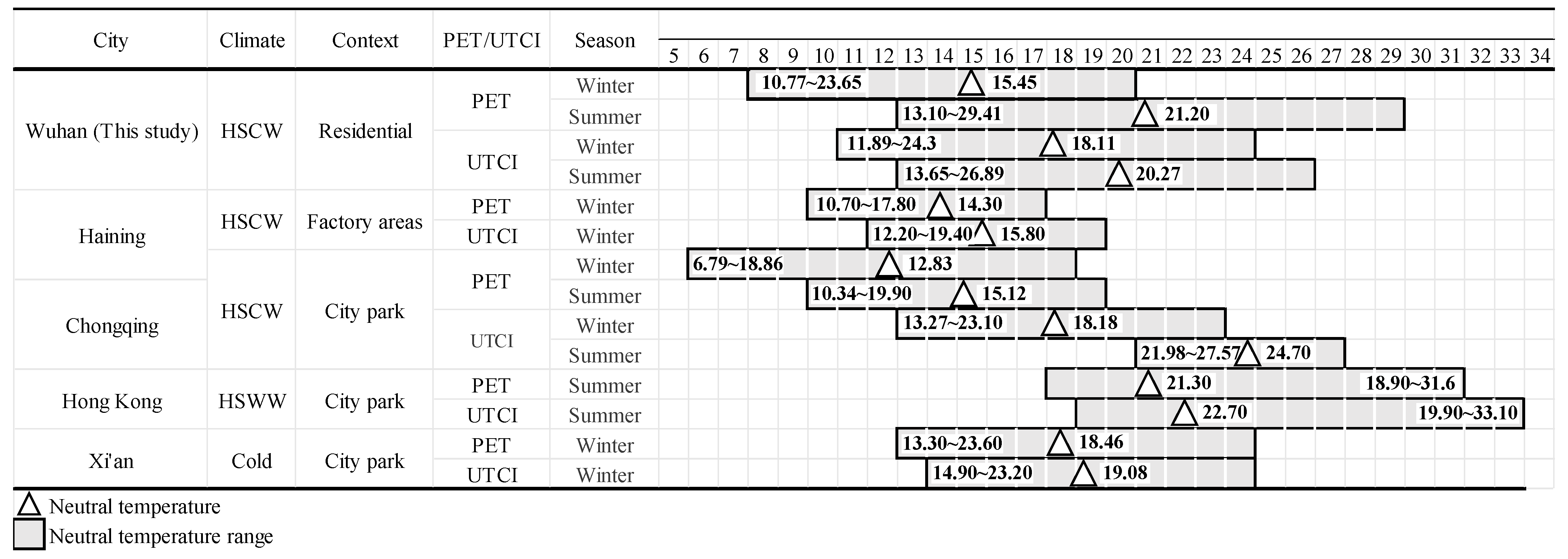

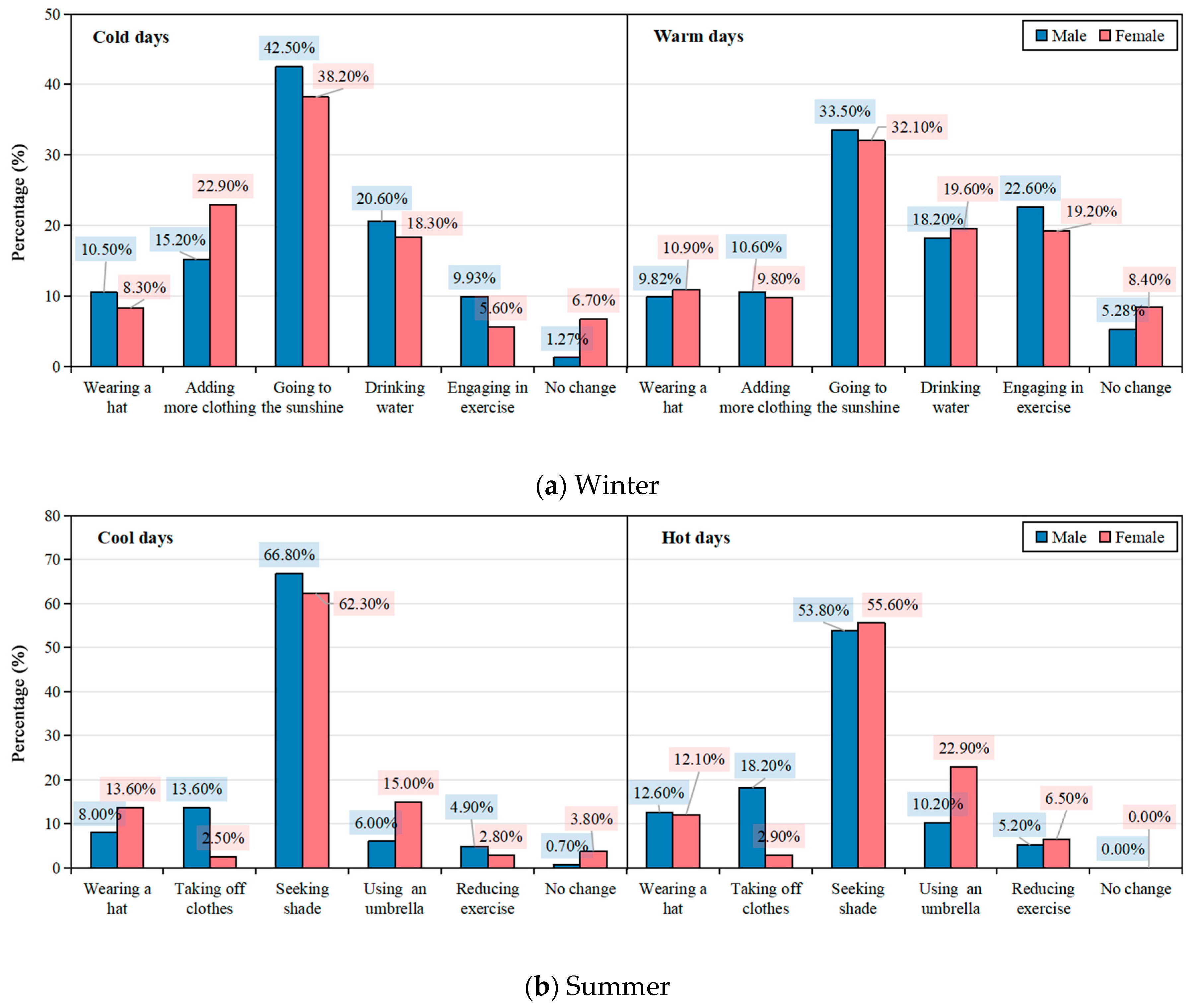
| Year | City | Season | Köppen Climate Classification | Objectives | People | Indicators |
|---|---|---|---|---|---|---|
| 2014 [30] | Tianjin | Winter and summer | Dwa | Park | Mixed ages | UTCI |
| 2016 [31] | Changsha | Winter and summer | Cfa | Outdoor public spaces | Young people | PET |
| 2018 [32] | Tehran | Four seasons | BWk | University campus | Mixed ages | PET, PMV, and UTCI |
| 2019 [33] | Hong Kong | Summer | Cwa | City park | Mixed ages | PET and UTCI |
| 2019 [34] | Mianyang | Winter and summer | Cwa | University campus | Young people | PET |
| 2019 [35] | Dhaka | Fall and summer | Aw | Residential, commercial, and educational area | Mixed ages | PET |
| 2021 [36] | Melbourne | January–February | Csb | City square | Mixed ages | PET |
| 2021 [37] | Xi’an | Winter and summer | Cwa | Park | Elderly people | PET |
| 2021 [38] | Belo Horizonte | Winter and summer | Aw | City square | Mixed ages | UTCI |
| 2022 [39] | Hangzhou | Winter and summer | Cfa | Scenic area | Young people | PET |
| 2022 [40] | Chandigarh | Winter and summer | Cwa | Prominent sites | Mixed ages | PET |
| 2022 [41] | Chongqing | Winter and summer | Cfa | Park | Mixed ages | PET and UTCI |
| 2023 [42] | Huangshan | Winter | Cfa | Community parks | Elderly people | PET |
| 2023 [43] | Haining | Winter | Cfa | Factory | Mixed ages | PET and UTCI |
| 2024 [44] | Dalian | Spring and fall | Dwa | Park | Mixed ages | UTCI |
| 2024 [45] | Xiamen | Winter and summer | Cfa | Park | Mixed ages | PET |
| 2025 [46] | Sistan | Summer | BWh | Outdoor public spaces | Mixed ages | PET and UTCI |
| 2025 [47] | Dhahran | Summer | BWh | Square | Mixed ages | PET |
| Measurement Point | Serial Number | Descriptions |
|---|---|---|
| Street Sites | A1, B1 | Located on streets perpendicular to building facades. Site A1 had impermeable ground surfaces with tall trees on one side, while Site B1 was flanked by buildings on both sides. |
| Roadway Sites | A2, B2 | Positioned on roads parallel to building facades, with D/H ratios of 1.67 and 2.67, respectively. Site B2 featured tall trees on both sides. |
| Shaded Areas | A3, B3 | Located under tree canopies, providing shaded conditions. |
| Open Spaces | A4, B4, A5 | Central courtyards surrounded by buildings. A4 had minimal daytime shade, while A5, situated in the northwest corner of the residential area, was more open and received ample sunlight. |
| Rooftop Sites | RA, RB | Located on residential building rooftops and used for collecting background meteorological data. |
| Measured Season | Date | Residential Areas | Measured Time | Surveys Time |
|---|---|---|---|---|
| Winter | January 9 | Gufeng community | 8:30–18:30 | 9:00–18:00 |
| January 11 | ||||
| January 12 | ||||
| January 13 | Xingfuli community | 8:30–18:30 | 9:00–18:00 | |
| January 17 | ||||
| January 18 | ||||
| Summer | January 30 | Gufeng community | 8:30–18:30 | 8:30–18:00 |
| January 31 | ||||
| August 2 | ||||
| August 6 | Xingfuli community | 8:30–18:30 | 8:30–18:00 | |
| August 7 | ||||
| August 8 |
| Youth | Middle-Aged | Elderly | Total | |||||
|---|---|---|---|---|---|---|---|---|
| Winter | Summer | Winter | Summer | Winter | Summer | Winter | Summer | |
| Male | 102 | 126 | 115 | 138 | 68 | 83 | 285 | 347 |
| Female | 85 | 103 | 96 | 109 | 49 | 64 | 230 | 276 |
| Total | 187 | 229 | 211 | 247 | 117 | 147 | 515 | 623 |
| Season | Categorization | Average Daily Temperatures |
|---|---|---|
| Winter | Cool day (Low temperature) | 5 ≤ Ta < 6 °C (January 13) 7 ≤ Ta < 8 °C (January 9, 11, and 12) |
| Warm day (High temperature) | 8 ≤ Ta < 9 °C (January 18) 10 ≤ Ta < 11 °C (January 17) | |
| Summer | Cool day (Low temperature) | 32 ≤ Ta < 33 °C (July 30) 33 ≤ Ta < 34 °C (July 31) |
| Hot day (High temperature) | 35 ≤ Ta < 36 °C (August 6 and 7) 36 ≤ Ta < 37 °C (August 2) 37 ≤ Ta < 38 °C (August 8) |
Disclaimer/Publisher’s Note: The statements, opinions and data contained in all publications are solely those of the individual author(s) and contributor(s) and not of MDPI and/or the editor(s). MDPI and/or the editor(s) disclaim responsibility for any injury to people or property resulting from any ideas, methods, instructions or products referred to in the content. |
© 2025 by the authors. Licensee MDPI, Basel, Switzerland. This article is an open access article distributed under the terms and conditions of the Creative Commons Attribution (CC BY) license (https://creativecommons.org/licenses/by/4.0/).
Share and Cite
Wang, M.; Zhang, C.; Wang, S.; Wang, H.; Chen, Q.; Xu, S.; He, B. Sensitivity of Human Thermal Comfort Benchmarks to Background Temperature and Individual Factors: An Empirical Study in Wuhan, China. Buildings 2025, 15, 3037. https://doi.org/10.3390/buildings15173037
Wang M, Zhang C, Wang S, Wang H, Chen Q, Xu S, He B. Sensitivity of Human Thermal Comfort Benchmarks to Background Temperature and Individual Factors: An Empirical Study in Wuhan, China. Buildings. 2025; 15(17):3037. https://doi.org/10.3390/buildings15173037
Chicago/Turabian StyleWang, Minghao, Chi Zhang, Siyao Wang, Huohua Wang, Qiwei Chen, Shen Xu, and Baojie He. 2025. "Sensitivity of Human Thermal Comfort Benchmarks to Background Temperature and Individual Factors: An Empirical Study in Wuhan, China" Buildings 15, no. 17: 3037. https://doi.org/10.3390/buildings15173037
APA StyleWang, M., Zhang, C., Wang, S., Wang, H., Chen, Q., Xu, S., & He, B. (2025). Sensitivity of Human Thermal Comfort Benchmarks to Background Temperature and Individual Factors: An Empirical Study in Wuhan, China. Buildings, 15(17), 3037. https://doi.org/10.3390/buildings15173037








